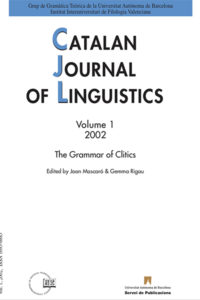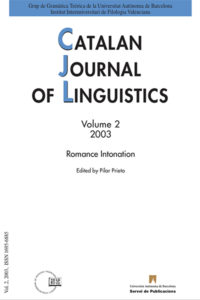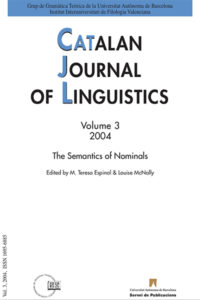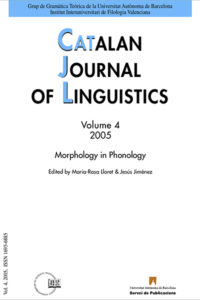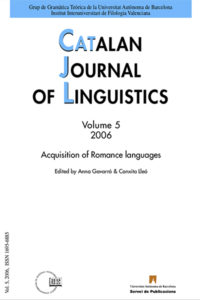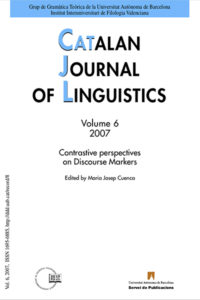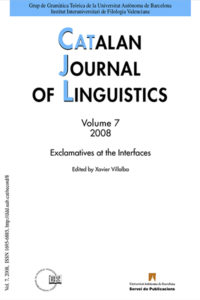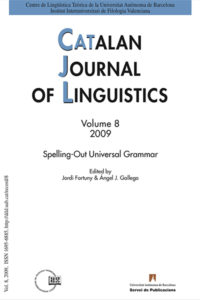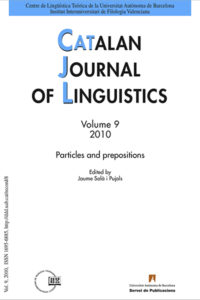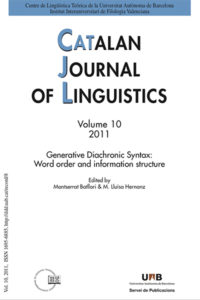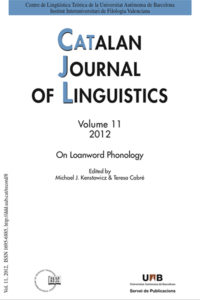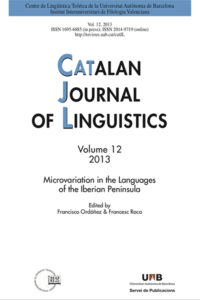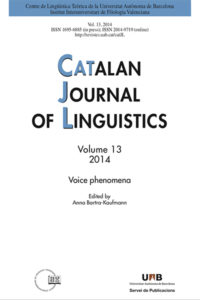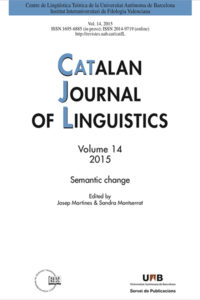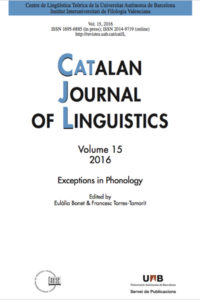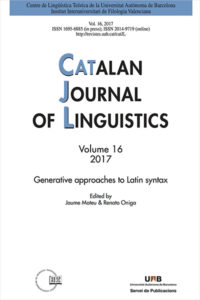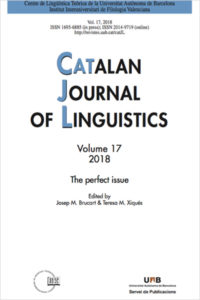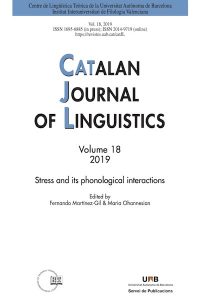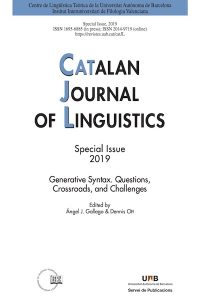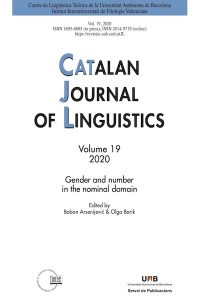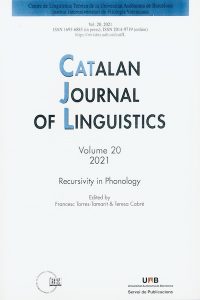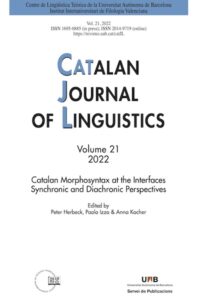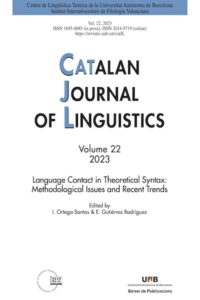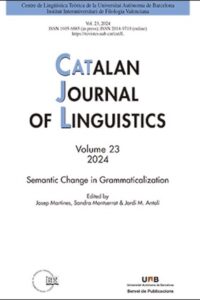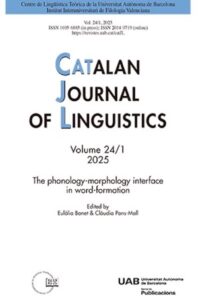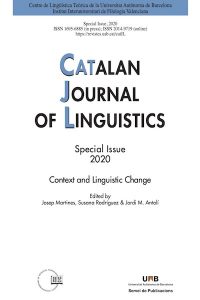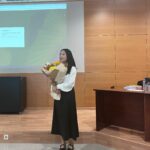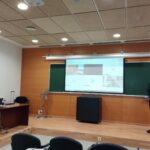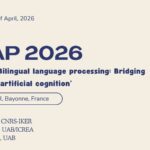28 gener, 2021
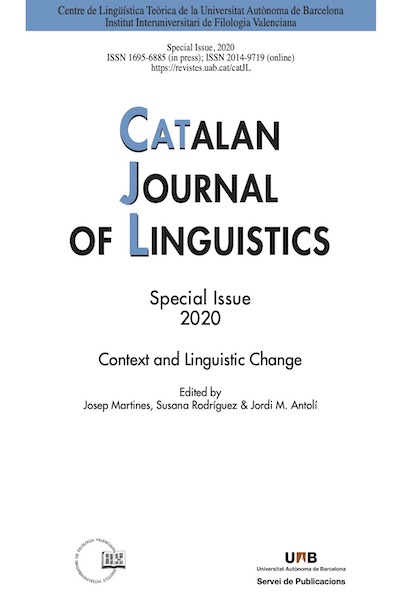
Autors:
Martines, Josep, Susana Rodríguez & Jordi M. Antolí (eds.)
Títol:
Context and Linguistic ChangeEditorial: Bellaterra: Servei de Publicacions de la UAB
Col·lecció: Catalan Journal of Linguistics #2020 SpecialData de publicació: 2020
Pàgines: 204 Text complet
The papers integrating this special issue aim at shedding light on the many research possibilities suggested by usage-based linguistics. All the contributions have different goals, focus on different languages (Catalan, English, Spanish or Portuguese), use several chronological frameworks (there are diachronic and synchronic analysis) and approach a variety of linguistic elements. However, despite this seeming heterogeneity, all the papers share a similar methodology and a conception of linguistic communication – and, specifically, of linguistic change – strongly based on usage.
Títols de la col·lecció / Also in this series:
18 gener, 2022
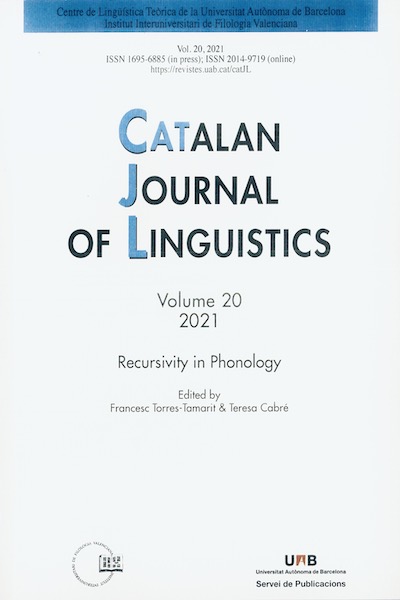
Autors:
Francesc Torres-Tamarit & Teresa Cabré (eds.)
Títol:
Recursivity in PhonologyEditorial: Bellaterra: Servei de Publicacions de la UAB
Col·lecció: Catalan Journal of Linguistics #2021Data de publicació: 2021
Pàgines: 114 Text completIn November of 2019, a two-day workshop on "Recursivity in Phonology: below and above the word" was organized at the Universitat Autònoma de Barcelona. The workshop featured Emily Elfner (York University, Canada), Junko Ito and Armin Mester (University of California, Santa Cruz) as keynote speakers. The following questions were addressed: does recursivity in phonology exist at all? If recursivity in phonology exists, what exactly can trigger a recursive structure in the syntax-prosody interface? Is recursivity restricted to higher-ordered phonological constituents like the phonological phrase and the intonational phrase? Does ternarity exist in phonology or should it be derived from recursive structures?
This 20th volume of the Catalan Journal of Linguistics presents a selection of the papers that were discussed during the workshop.
Títols de la col·lecció / Also in this series:
25 gener, 2023
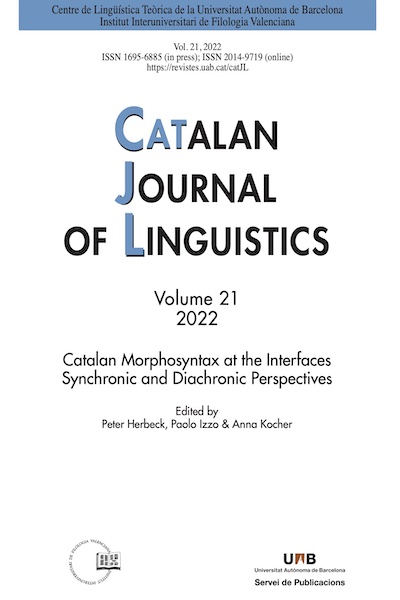
Autors:
Peter Herbeck, Paolo Izzo & Anna Kocher
Títol:
Catalan Morphosyntax at the Interfaces - Synchronic and Diachronic PerspectivesEditorial: Bellaterra: Servei de Publicacions de la UAB
Col·lecció: Catalan Journal of Linguistics #2022Data de publicació: 2022
Text completThe aim of the special issue Catalan Morphosyntax at the Interfaces is to gather recent investigations and offer new insights into Catalan core grammar and its inter-faces. This volume presents an extensive picture of the current research focused on Catalan grammar both from a synchronic and a diachronic perspective. The studies attain new theoretical findings relying on a strong empirical background. The contributions deal with interface phenomena in the verbal and (pro-) nominal domain. The main topics addressed are the following:
— the morphosyntax of clitics in Catalan and its varieties
— the nature and structure of different (pro-)nominal forms
— morphosyntax and the verbal domain (tense, aspect, word formation)
— Catalan morphosyntax and the interface to semantics, pragmatics, and phonol-ogy
Títols de la col·lecció / Also in this series:
30 juny, 2023
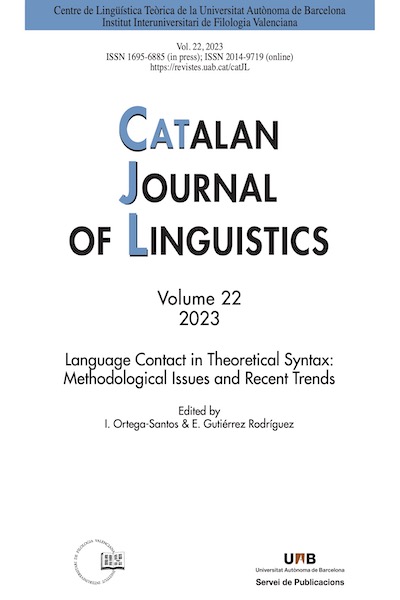
Autors:
I. Ortega-Santos & E. Gutiérrez Rodríguez (eds.)
Títol:
Language Contact in Theoretical Syntax: Methodological Issues and Recent TrendsEditorial: Universitat Autònoma de Barcelona, Servei de Publicacions
Col·lecció: Catalan Journal of Linguistics #2023Data de publicació: 2023
Pàgines: 148 Més informació
Text completWhile most syntactic research has naturally focused on varieties spoken by (supposedly) monolingual speakers, the study of language contact stands out as particularly relevant not only as celebration of linguistic diversity, but also from the theoretical point of view. For one thing, it expands the number of syntactic context available to test hypotheses by adding contact varieties and heritage languages as well as phenomena such as code-switching into the picture. Moreover, the study of language contact presents data collection challenges, which speak directly to ongoing debates on data collection standards in the field of syntax. In particular, there is an ongoing trend towards the adoption of experimental data collection methods and statistical analysis and/or the use of crowdsourcing and citizen science (e.g., see Gallego and Ortega-Santos 2019). Language-contact phenomena correspond to highly specific geolects/sociolects that are not necessarily spoken by the researchers. Thus, researchers are faced with the question of how to gather the data most efficiently and with generalizability; crucially, these issues are discussed explicitly in the corresponding publications, in contrast to most non-experimentalist or non-variationist syntactic research, thus helping the field of theoretical syntax as a whole adopt experimental data collection protocols. Furthermore, the study of language contact has figured prominently in the study of language change, with an emphasis on the extent to which language contact may cause syntactic changes – changes in the I-grammar, say, parameter resetting – and, if so, under what conditions (see Meisel et al. 2013 and references therein). Last but not least, this is also an area relevant to the study of external factors (e.g., language identity or language shift). As such, it lends itself to interdisciplinary work and hopefully crosspollination inthe study of the relationship between the grammar/competence and more usage-based notions such as frequency.
Títols de la col·lecció / Also in this series:
28 octubre, 2024
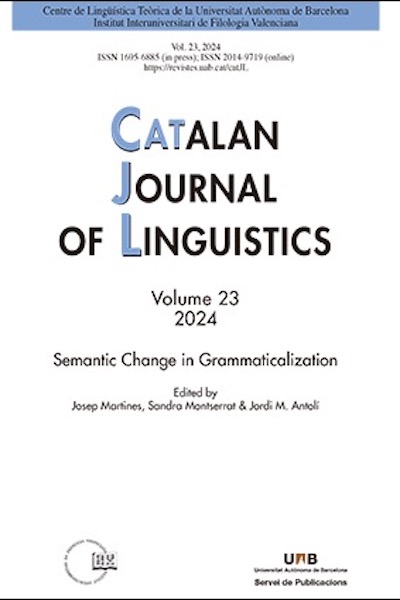
Autors:
J. Martines Peres, S. Montserrat Buendia & J. M. Antolí Martínez (eds.)
Títol:
Semantic Change in GrammaticalizationEditorial: Universitat Autònoma de Barcelona, Servei de Publicacions
Col·lecció: Catalan Journal of Linguistics #2024Data de publicació: 2024
Pàgines: 324 Més informacióIn recent decades, diachronic semantics as a discipline has undergone a revolu-tion. Firstly, because the very concept of meaning has been broadened: whereas traditionally diachronic semantics focused on the study of lexicon, it is now agreed that not only the lexicon is a bearer of meaning, but also morphemes, phraseologi-cal units or grammatical constructions contain a semantic load. Consequently, this expansion of the field of study has been accompanied by a re-evaluation of the dis-cipline: diachronic semantics has gone from being on the periphery of the study of linguistic change to being considered a core subject. The importance that semantic change has acquired in the study of grammaticalization is paradigmatic of all this: Semantics and Pragmatics have become fundamental disciplines for explaining the origin of grammatical change and the context in which it occurs.
At first, studies on grammaticalization (see, for example, Lehmann 1995) focused on the description of the criteria defining the change and the semantic, morphosyntactic and phonological patterns involved. In these early studies, the role given to semantic change was minor, and it was mainly observed that gram-maticalization entailed a loss of meaning (semantic bleaching) between the source units and the grammaticalized units.
In a second stage, studies such as those by Traugott (1989, 2010, among oth-ers), Traugott & König (1991), Hopper & Traugott (1993) or Traugott & Dasher (2002) placed semantics and pragmatics at the center of interest. Along with the semantic bleaching associated with grammaticalization processes, it was pointed out how grammaticalization also entails the encoding of pragmatic values in the new grammaticalized units that the source units did not possess.
Moreover, cognitivist and, more generally, usage-based approaches have offered new answers to a fundamental question about the process of grammati-calization: Why does change occur? Along with the well-known formal reasons (such as the power of analogy), in recent decades the importance of the discursive context in the initiation of these phenomena of change has been emphasized. To this end, the pragmatic analysis of concrete communicative contexts and the application of concepts such as bridging context and invited inference, which E. C. Traugott integrates in the Invited Inferencing Theory of Semantic Change (IITSC), are fun-damental. Grammaticalization, according to this theoretical framework, originates when the encoded meaning is enriched with pragmatic values that arise from con-crete communicative contexts as a result of invited inferences. The conventionaliza-tion of these new values, with the formal changes that this entails, opens the way to grammaticalization.
Within this context, this special issue explores the place of semantic change in grammaticalization and studies cases of grammatical change with a focus on semantic change. In this sense, a selection of studies is offered that combine works with a greater theoretical weight, which a) analyze the development of the concept of grammaticalization and the place attributed to semantic change, b) deal with the correlation between semantic change and other aspects of linguistic change (syntax, morphology, phonology) and c) analyze the intersection between grammaticalization and other patterns in linguistic change (phraseologization, constructionalization). These works of a theoretical nature are combined with case studies, mainly, but not only, focused on Romance languages (and specifically on Spanish and Catalan). These empirical studies are based, in all cases, on historical data from linguistic corpora or on interlinguistic comparison.
Títols de la col·lecció / Also in this series:


